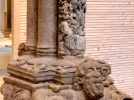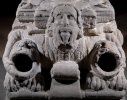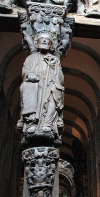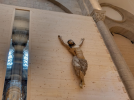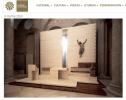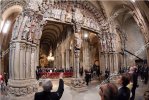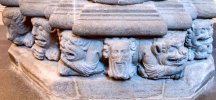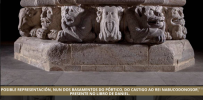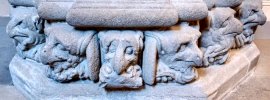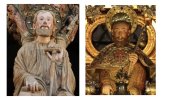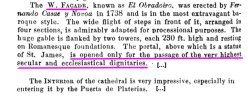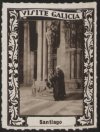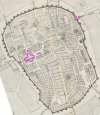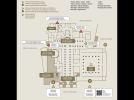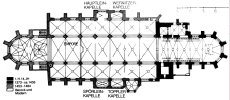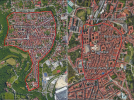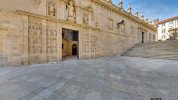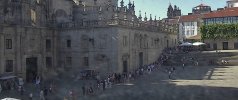FWIW, Baedeker, a widely known publishing house for travel guides founded 200 years ago - a kind of pioneer and authority in their field, published a guide for Spain in English in 1898. It describes the Cathedral of Santiago at the time:
View attachment 166810
We have this idea that pilgrims climbed the great stairs on Obradoiro square and entered the cathedral through the Portico de la Gloria for centuries and centuries, and now we are denied this. Has it really been like this? You be the judge ...

.
That "
opened only for the passage of the very highest secular and ecclesiastical dignitaries" sounds completely wrong.
Typically, the principal doors of a large church remain closed, and worshippers enter through such side doors as can be seen here (and in the case of this particular Cathedral, also the North and South entrances, plus the Holy Dear in Holy Years) :
The Portico as such comprises the whole structure, including both main doors and side doors -- the part of it in question is however
not accessible through those side doors, as it is walled off from them, as can be seen here :
I can remember using one and/or other of those side doors to exit the Cathedral, as traffic through the main doors was one way only.
The central doors of a cathedral are not opened "for dignitaries" only (though of course they certainly could be), but typically they are opened for Sunday Mass and for Feast Day Masses -- the Cathedral in Santiago currently not doing this except on some major Feast Days is an exception to typical practices.
Those doors should in theory have opened four days ago on Palm Sunday, as the liturgy for the Palm Sunday Mass commences on the porch of the church, and the Parish Priest (in this case the Bishop) calls from outside demanding entry into the church, the doors are opened following some ritual protests, and then the congregation streams in following the priest through the doors into the church -- but in actual fact, they remained closed, and instead the Bishop and the Congregation entered through the southern door. This was likely to have been for practical and processional reasons.
However, as you can see, they were open on the Feast Day of the Apostle last year, of course only to those with the correct invitation to the Celebration :
VIDEO: Santa Misa presidida por el arzobispo de Santiago de Compostela, Francisco José Prieto

www.cope.es
You can nevertheless see that quickly after the Bishop began proceeding towards the altar, the doors were closed.
Apart from that, it is seemingly possible to get a guided visit to the Portico de la Gloria ; whether or not these visits enter through the main door or not, I haven't the foggiest -- though the above photo suggests not.
In some cases, a church can have an outer door, remaining open, then an an inner central door usually closed, and two interior side entrances. As above, that central internal door will open for Sunday Mass. At the church where I was baptised, that's mostly to make passage easier for the Congregation to leave after Mass. That was the same at my Parish church, but the interior doors are broken so we make do.
Each church does have its own practices regarding its main doors -- Notre Dame in Paris kept them open on ordinary week days (if that's still the case in future remains to be seen), whereas Notre Dame in Chartres keeps them closed, for example -- however, these practices can and do change over time ; so that whilst the central doors in Santiago were generally kept closed in 1898, and are kept closed in 2024, they were kept open in the 1980s and 1990s and at least until the late 2000s. So that 1898 report has little relevance to the typical state of affairs over the centuries, as does not the present situation (which the current Bishop is reportedly unhappy with).
I have no idea of when the practice of keeping them open during the 20th and early 21st Centuries had started, though I do seem to remember that the need for the recent restoration is what prompted their closure 15 years ago or so. They were closed anyway in 2014, and had been for some time.
Personally, I entered the Cathedral through those main doors in 1993, 1994, and 2005 -- and I placed my hand on that column in 1994 (in 1993 I was unaware of that old custom, and in 2005 a barrier had been put in place to prevent it).
Nevertheless, the erosion to the column in that hand imprint is hard evidence that vast numbers of pilgrims over the centuries have engaged in that practice, which is now only ever allowed by an especial permission as I understand things, so that it is quite clear that keeping those doors closed is not the norm for the Cathedral, but that it is an exceptional measure.
---
BTW here is a partial reconstitution of what the Portico would have looked like, more or less, in the 11th or 12th Century :
It was repainted in the 17th and 19th Centuries, each time less colourfully ; and some trace remnant of the 19th Century colours was visible in the upper area prior to the restoration work.
I do not know if there is any project to restore the pigmentation.












